May 24 - 30, 2015: Issue 215
CRIMSON ROSELLAS
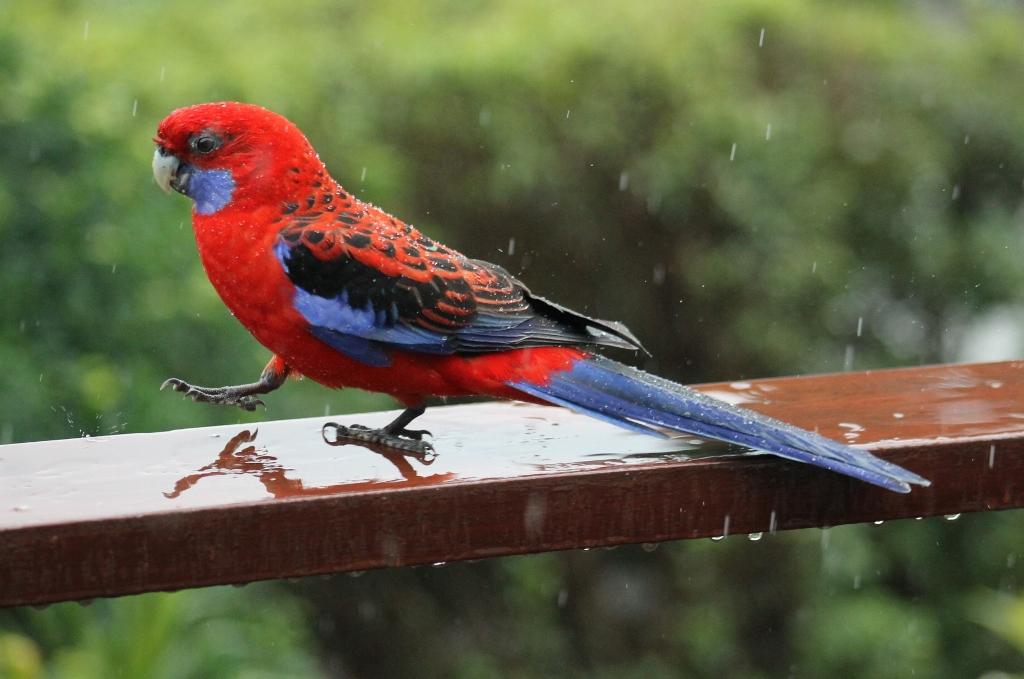
Crimson Rosella at Palm Beach - photo by A J Guesdon, 2015.
By Kathleen Dalziel
Once more the rowan covers her bowers with richest hue,
And all the berry-lovers, a feathered robber crew.
Come flying to the crimson feast, the bandits of the blue.
Before the poplars yellow and autumn marches by
Each gathers with bit fellow, bright wing and brighter eye.
What time the berries mellow beneath summer sky.
While still the gums are flaunting their blooms like creamy curds.
The happy thieves come haunting the boughs, with friendly words:
Oh, there's nothing so enchanting as the small talk of the birds.
As they chuckle, feast, and chatter In Joyous companies.
With whistle and sweet patter, with low soliloquies,
On this and that gay matter, the gossip of the trees.
And the winds repeat the story, and the little creek replies.
Till evening flings her glory about the western skies,
And the robbers leave the rowan trees, bright wings and brighter eyes.
Before the young moon's sandals are silver on the dew;
Beneath the first star-candles they vanish from our view,
The gaily painted vandals, the pirates of the blue.
CRIMSON ROSELLAS. (1934, March 17). The Australasian(Melbourne, Vic. : 1864 - 1946), p. 6. Retrieved fromhttp://nla.gov.au/nla.news-article141401275
LITERARY. RECOGNITION FOR AUSTRALIAN WRITER.
National literary recognition has been accorded to Mrs. Kathleen Dalziel of Malvern, whose poem, "The Plum Tree." has been accepted for inclusion in 'The World's Fair Anthology of 1939 to be published by "'The Exposition Press," New York City. The author, who competed in a 100.00 dollar poetry prize contest still open to all poets, had to withstand tremendous meritorious competition in order to becomee one of the comparatively select few chosen for representation in "The World's Fair Anthology." The author has achieved success in other channels. She is a member of P.E.N. Club and a member of Fellowship of Australian Writers. Her husband. Mr. Wm. Dalziel, is on the staff of the Mental Hospital at Araratt. LITERARY RECOGNITION FOR AUSTRALIAN WRITER. (1939, May 23). The Horsham Times (Vic. : 1882 - 1954), p. 2. Retrieved from http://nla.gov.au/nla.news-article73022641
AN AUSTRALIAN SINGER
KNOWN AND NOT HELD, verses by
KATHLEEN DALZIEL (Melbourne: Bread and Cheese Club).
Pursuing Its policy of presenting Australian writers to Australian readers, the Bread and Cheese Club sponsors this collection of some 2 score short poems by Kathleen Dalziel. Most of them have already been printed in various Australian journals and magazines. Miss Dalziel has been in the past a frequent contributor of verse to The Australasian.
All of her work is marked by a characteristic delicacy of expression and imagery. Her love of nature is reflected, in most of her verses. Thecountry, the orchard, birds, and the seasonal cycle are her favourite sources of inspiration. There is a gaiety in Miss Dalziel's songs that forms happy contrast to the atmosphere of melancholy that affects so much of contemporary Australian poetry. She grasps the sunshine and lets the shadow's slip -through her fingers. "Known and Not Held" is not a large contribution to our verse but it is sweet and sincere. AN AUSTRALIAN SINGER. (1941, September 13). The Argus(Melbourne, Vic. : 1848 - 1957), p. 8. Retrieved from http://nla.gov.au/nla.news-article8204361
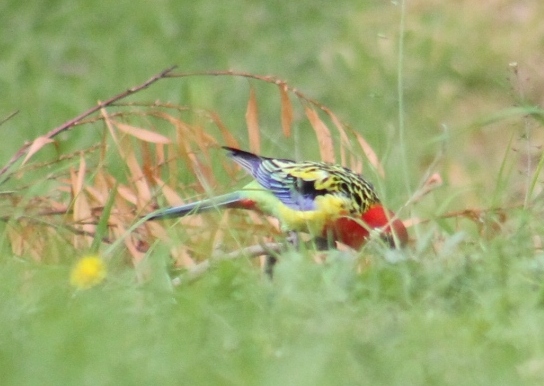
OR, A MORNING IN THE MOUNTAINS.
BY CHARLES HARPUR.
AT length a belt of cedars tall
In a broad scoop, (a) and undertwined
With brushwood of each gadding kind.
And with the rankest vines, — is all
That interposing hides a scene
Where hunter never hath bootless been.
'Tis entered — and a sound up springs,
Of lashina boughs and rushing wings!
In a disultorious throng,
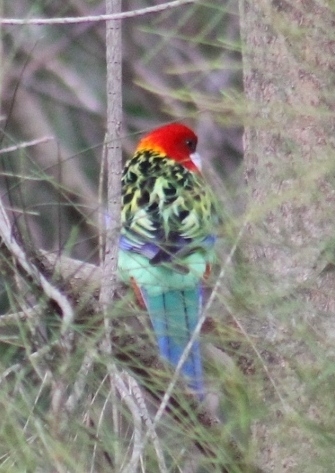 Before, athwart, above, along,
Before, athwart, above, along,What birds their varied plumes display —
Many and beautiful are they!
The dove on burnished pinion strong
Hurries afar in sounding flight,
And the yerowalas (b) unfold
Their pointed wings of verdant gold
And fleetly flaming to the light
Above the doming cedars' height,
Each one singly hits the view
Like a volant crysrolite.
And the rosella flashes through
The foliage; — orange, green, and blue
Mingling to one checkered hue,
It seems a creature of rainbow birth,
Though somewhat tarnished by the damp
Of its after life on earth;
Or the scarlet satin bird (c)
Hangeth like a golden lamp
Where the berried bird is stirred:
While haply the king parrot, showing
Fall aloft his broad red breast,
Like a vast blood-rich ruby glowing,
Near it boldly sits at rest.
Or troops of rooks in loud alarm
Mount the trees from arm to arm; (d)
While crowds of nameless twittering things
With rich-ringed glossy eyes, and necks
All streaked and interstreaked, and wings
Spangled with rows of spark-like specks,
And tails with broad barred blazonings.
And crimson backs, and bosoms bright
As the breast of a cloud in a sunset sky,
Or glance afar in gleamy flight
O'er the leafy domes of the cedars high,
Or lighten through the nearer shade,
Or sparkle aloft like stars new-rayed,
Or stream in flocks, fright-disarrayed,
Like shattered meteors by! (e)
With these the noisy yellow-bill,
And the ground parrakeet, (f) screaming shrill
As out of some high tussock near
It starts at once into the clear,
And seems while swiftly shooting higher
Imped with plumes of subtle fire;
So vividly it hues the light
As thus it blazes forth in flight;
And the whining quail that skims the brush,
And the soaring pie, (g) and the dodging thrush,
Precede the hunter as he pushes
Through clinging vines and flaunting bushes,
Or sternly chides the loitering dog
That scents the wild cat in the hollow log,
Or one that in pursuit would fly
As oft the dooaralli (h) rushes bounding by.
(a) Or delve, as I had written in explanation, But looking into Johnson, I find the word delve denned as a ditch, a pitfal, a den, &c. I had previously understood it to mean a broad dip in the land, regularly bevelling from side to side, as if scooped out by art; and I still fancy that this is the idea it would convey to the country English, and to all those who have ruralised somewhat more than great lexicographers are in the habit of doing.
Delves, then, or scoopes of the kind mentioned in the text, are often several miles long, by about a quarter of a mile wide, though in places much narrower. And even when they occur on table lands, or on the backs of broad ridges, the soil in them is more than commonly fertile, it being chiefly an alluvion from the rising grounds on either side. Hence they are always thickly timbered, and with trees of an extraordinary height, and are densely brushed besides with white cedars, kerrijongs, and a great variety of wild vines and wood-creepers. Out of this under-mass of umbrage, the boles of the taller trees
shoot up like crowds of pillars, supporting far aloft a second edition of dense foliage intertwined with runners of the kind described in a note to a subsequent portion of the Poem; and which mass of greenery, but for these its pillary supporters, were not unlike in distant appearance to a long and heapy stratum of darkly verdant cloud.
The multitude and variety of the feathered inhabitants of localities such as these are easily accounted for, by the fact, that many of the vines and creepers peculiar to them, are exceedingly prolific of seed-berries, and are besides the 'murmevrous haunts' of innumerable insects.
(b) Yerowala is an aboriginal name of the blue-mountain parrot — the most splendid, to my thinking, of all our parrots. The rosella may be the more showy bird for a moment, but even it will bear no comparison with the blue-mountainer. Those persons who have only seen this bird encaged, can have but a very imperfect notion of its native beauty. To arrive at an adequate idea of this, we must snare or shoot in the forest a full plumed cock yerowala; and then the lustrous green of the whole back and wings, the bright yellow of the breast, and the indescribable blue of the head, do indeed compose for it an array most royal.
(c) This species of the satin-bird is somewhat rare. The whole of the back, including the wings, is of a bright red or scarlet. In a commoner sort the back and wings are of a glossy black; and in another species (if I recollect aright) the same divisions of the plumage are of a vivid straw color.
But our future ornithologists will look in vain for many kinds of birds which they will find mentioned in the earlier colonial records. Being rare even at first, these beautiful creatures often become extinct, and partly for the reason, that not only species, but whole genera of birds are confined in Australia to special, and, in some cases, very limited localities. I do not know whether this is so much the case in other new countries, but any observer of such matters who has travelled far into our interior, must be well aware that such is very remarkably the fact here. I have myself seen two sorts of parrots in the Kerrijong district that I have never seen elsewhere, and particular birds in particular localities that I have beheld out of them. Nay, I saw, when a boy, in the wood about Windsor, no less than four peculiar kinds of birds, which I have never since met with, although I have travelled extensively over the country, and in almost every direction.
The unchecked increase of the large tree climbing guana in the waste portions of those districts in which the aboriginals have become extinct or nearly so, is a main cause of the extinction also of many kinds of our native birds. So numerous have these guanas become in the woods of our partly located districts, that in passing through these a mid-summer, we are apt to start one of them up every second or third tree; and hence, in such places only the nests of those birds that incubate early in the Spring and wholly exempt from the liability of being plundered by them. And if only for this reason, it is a pity that we Colonists do not esteem them as great a table delicacy as our sable forerunners — the former lords of the soil — undoubtedly did. For no doubt, when not too old, they are excellent eating, — something in taste between fish and fowl; and when baked, as the Blacks bake them, — that is covered up like a damper in hot ashes, they have an exceedingly rich and stomach-provoking savour.
(d) What is here called the rook is a gregarious bird having much the appearance of our black magpie, but with less white under the wings and none in the tail. When at rest or alight, it appears to be thoroughly black, the white places under the wings being only perceptible while they are spread in flight. On being started from the ground, where it feeds, it, flies heavily to one of the lower arms of the nearest tree, from which it then hops to a higher, and a higher, as described in the text, rounding the trunk at each stage of ascent, until it reaches the top, — when, deeming itself pretty safe it would seem, it quietly looks down upon the cause of its previous alarm.
(e) Those persons who are unacquainted with the surprising brilliancy of many of our native birds, may be inclined to question the descriptive veracity of the text. They may suspect that its illustrations are too glossy, as the phrase goes. Yet its most vivid pictures are but faint copies of the originals. How indeed could the splendour of the regent bird, for example, be adequately compassed in words, or fully granted even in idea? That superb creature must be seen with the bodily eye, and in the full plumed glow of its forest freedom, ere we can have a believing conception of anything so gorgeous. Then the diamond -bird, with its sky-blue wings bedroptd with miniature stars, — how flight a poet fully describe it, or a painter, even sufficiently paint it? And so of many others of our Australian birds — 'things of beauty' that Poetry can only catalogue at the best, and Painting suggest.
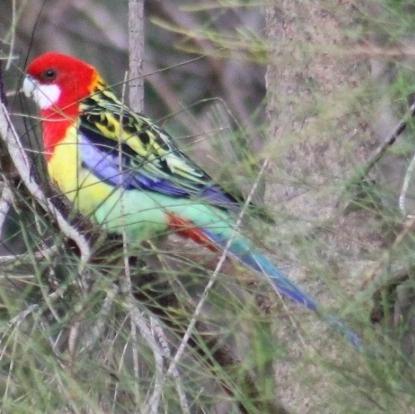 (f) What is here called the ground parrakeet, from its always feeding upon the ground — on grass seed it is likely — is a small bird of exceeding beauty. To some extent it is even more splendid than the Yerowala. Its prevailing colour is green, variagated with bright yellow blazes in the wings and tail. While at rest, however, it is a small queen bird of no very brilliant appearance; but no sooner are its wings and tail dispread in flight, than it becomes vivid as fire. There are, however, several varieties of this kind of parrot, all some-what different coloured; and one of these, though less splendid than the one above described, is yet more intensely beautiful upon a close inspection.
(f) What is here called the ground parrakeet, from its always feeding upon the ground — on grass seed it is likely — is a small bird of exceeding beauty. To some extent it is even more splendid than the Yerowala. Its prevailing colour is green, variagated with bright yellow blazes in the wings and tail. While at rest, however, it is a small queen bird of no very brilliant appearance; but no sooner are its wings and tail dispread in flight, than it becomes vivid as fire. There are, however, several varieties of this kind of parrot, all some-what different coloured; and one of these, though less splendid than the one above described, is yet more intensely beautiful upon a close inspection.(g.) As I have before noted, there are at least two kinds of so called magpies — the 'black and white,' or Australian magpie proper, and the 'black' or migratory magpie, a bird less spotted.
Both of these birds are remarkable for the beauty of their eye, though the former is not in this respect at all comparable with the latter ; the eyes of which are so strikingly fine, that my son Washington, when about four years old, was wont to refer to it through this characteristic — calling it 'the big black bird with the new eyes.'
(h) Dooralli is the name the Blacks of some parts of the interior give to the animal commonly called the Kangaroo-rat.
(To be continued.) THE KANGAROO HUNT; OR, A MORNING IN THE MOUNTAINS. (1860, October 6). The Australian Home Companion and Band of Hope Journal (Sydney, NSW : 1859 - 1861), p. 13. Retrieved fromhttp://nla.gov.au/nla.news-article72484897
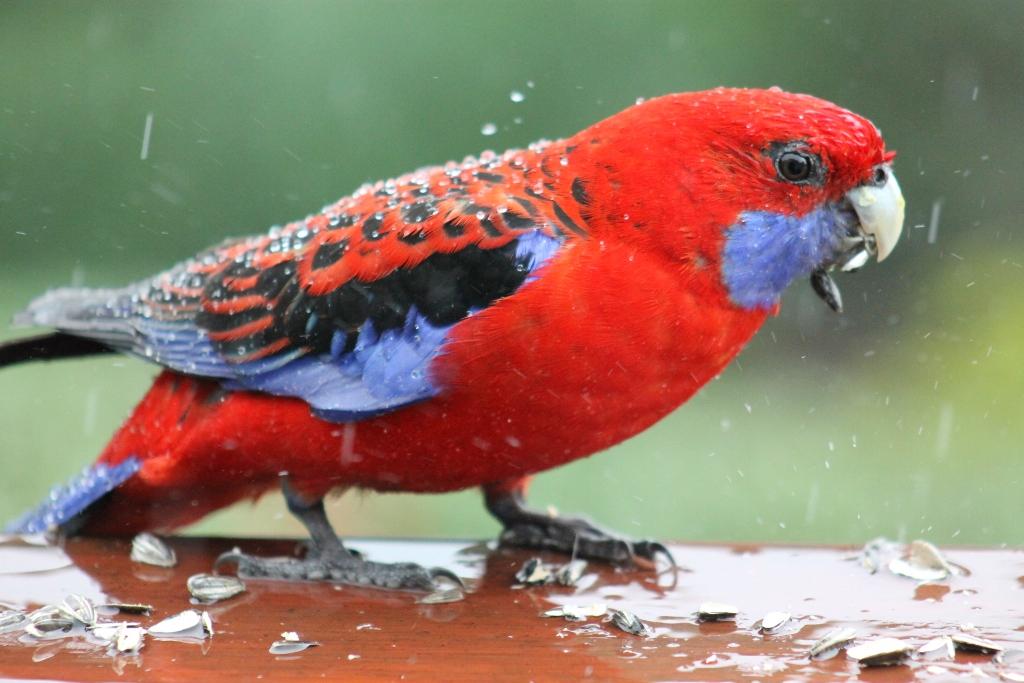
Also see Eastern Rosella - sample below: 2013 picture by A J Guesdon.
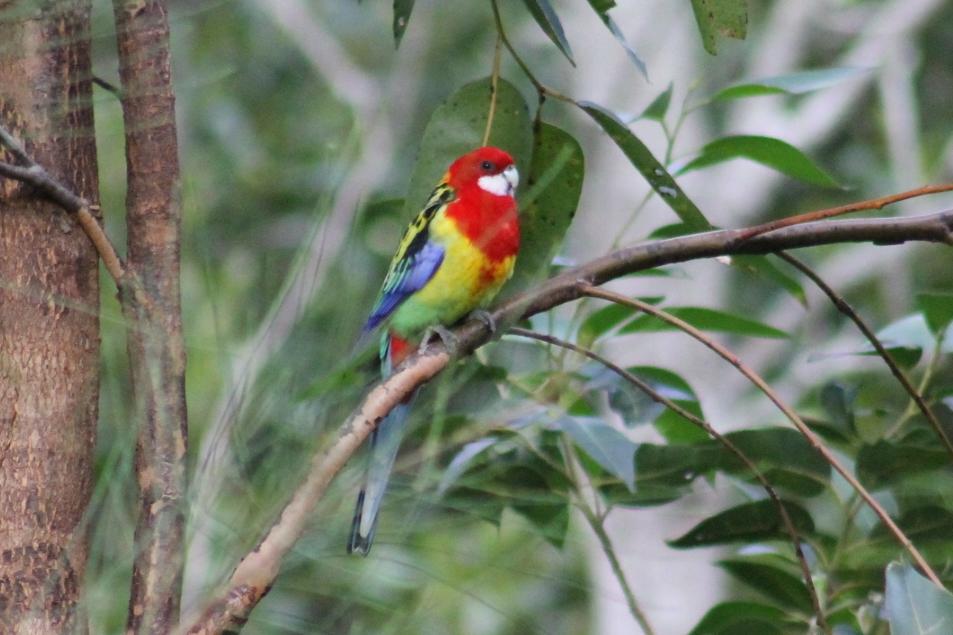
Crimson Rosella - Past and Present Facts
The crimson rosella (Platycercus elegans) is a parrot native to eastern and south eastern Australia which has been introduced to New Zealand and Norfolk Island. It is commonly found in, but not restricted to, mountain forests and gardens. The species as it now stands has subsumed two former separate species, the yellow rosella and the Adelaide rosella. Molecular studies show one of the three red-coloured races, var. nigrescensis genetically more distinct.
Though described by Johann Friedrich Gmelin in Systema Naturae as Psittacus elegans in 1788, the crimson rosella had been described and named by John Latham in 1781 as the Beautiful Lory, and then Pennantian Parrot. However he did not give it a Latin name until 1790, when he named it Psittacus pennanti. In 1854, it was placed in the genus Platycercus by Martin Lichtenstein in his Nomenclator Avium Musei Zoologici Berolinensis.
Today, the red-coloured races are generally known as the crimson rosella, with the alternate names Red Lowry, Pennant's parakeet, Campbell parakeet, (blue) mountain parrot, (blue) mountain lowry or just plain lowry occasionally heard. Cayley reported that the first two alternate names were most common in the early part of the twentieth century. On Norfolk Island it is called simply red parrot.
The yellow rosella, also known by a variety of alternate common names including Murrumbidgee lowry, murray rosella, swamp lowry and yellow-rumped parakeet, was described as Platycercus flaveolus by John Gould, who gave it the last common name mentioned. It was reduced to subspecies status once hybridization was noted where ranges overlap, however some authorities maintain the hybridization is not widespread and hence preserve its specific status. This view is in the minority, however.
Platycercus elegans is a medium-sized Australian parrot at 36 cm (14 in) long, much of which is tail. There are five subspecies, three of which are actually crimson. The red is replaced by yellow in the case of var. flaveolus and a mixture of red, orange and yellow in the Adelaide rosella.
Adults and juveniles generally show strikingly different colouration in south-eastern populations, with predominantly greenish-olive body plumage on the juvenile, most persistent on the nape and breast. Juveniles are said to 'ripen' as they get older and turn from green to red. All races have blue cheeks and black-scalloped blue-margined wings and predominantly blue tail with predominantly red coloration. The crimson rosella’s blue tail feathers are one of the favourite decorations of the satin bowerbird. The bill is pale grey and the iris dark brown.
Almost all rosellas are sedentary, although occasional populations are considered nomadic; no rosellas are migratory. Outside of the breeding season, crimson rosellas tend to congregate in pairs or small groups and feeding parties. The largest groups are usually composed of juveniles, who will gather in flocks of up to 20 individuals. When they forage, they are conspicuous and chatter noisily. Rosellas are monogamous, and during the breeding season, adult birds will not congregate in groups and will only forage with their mate.
According to a new study Crimson Rosella's can identify birds of their own subspecies based on the smell of other birds. (1.)
1."Birds can sniff out their own species". Australian Geographic. August 2014. At: www.australiangeographic.com.au/news/2014/08/birds-can-smell-their-own-species
Crimson rosella. (2015, April 6). In Wikipedia, The Free Encyclopedia. Retrieved from wikipedia.org/w/index.php?title=Crimson_rosella&oldid=655174237
Australian Birds. No. XVI.
FARM, ORCHARD, AND VINEYARD PESTS.
PLATYCERCUS ELEGANS, GMELIN.
Pennant's Parrakeet, "Lowry."
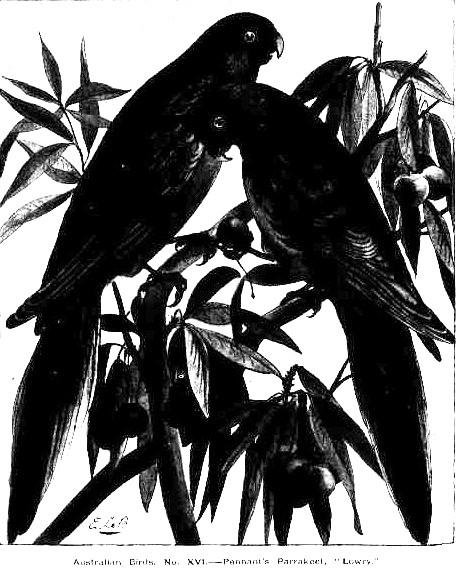 Pennant's Parrakeet, or '-'Lowry," as it is more frequently called throughout the eastern and south-eastern portion, of the Australian continent, is another species which plays sad havoc with the crops, of the orchardist and agriculturist. Like the Rosehill Parrakeet, which ' is frequently found in the same localities, if it is not engaged during' the fruit season in plundering the crops of the orchardist and vigneron, it is probably due to the fact that it is directing its attention to the young maize cobs growing in the fields of the agriculturist. In the coastal districts of New South Wales they are especially numerous and destructive during the months of March and April, when the young birds of the previous season, with their parents, flock together and feast upon the fruit or grain crops. But it is needless- to specialise any particular district, for this species is freely distributed through-out the eastern portion of Queensland, from the neighborhood of Cardwell most parts of New South Wales and Victoria, and the south-eastern portion of South Australia; and Kangaroo Island. It is also found on Norfolk Island, but it has probably been introduced there from Australia. Heavily timbered mountain ranges, as well as open forest lands, are alike resorted to by this species, and it is in newly-made clearings in these localities they are most frequently met with. It passes portion of its time on the ground in search of seeds of various grasses, which, with wild berries, constitute its usual food.
Pennant's Parrakeet, or '-'Lowry," as it is more frequently called throughout the eastern and south-eastern portion, of the Australian continent, is another species which plays sad havoc with the crops, of the orchardist and agriculturist. Like the Rosehill Parrakeet, which ' is frequently found in the same localities, if it is not engaged during' the fruit season in plundering the crops of the orchardist and vigneron, it is probably due to the fact that it is directing its attention to the young maize cobs growing in the fields of the agriculturist. In the coastal districts of New South Wales they are especially numerous and destructive during the months of March and April, when the young birds of the previous season, with their parents, flock together and feast upon the fruit or grain crops. But it is needless- to specialise any particular district, for this species is freely distributed through-out the eastern portion of Queensland, from the neighborhood of Cardwell most parts of New South Wales and Victoria, and the south-eastern portion of South Australia; and Kangaroo Island. It is also found on Norfolk Island, but it has probably been introduced there from Australia. Heavily timbered mountain ranges, as well as open forest lands, are alike resorted to by this species, and it is in newly-made clearings in these localities they are most frequently met with. It passes portion of its time on the ground in search of seeds of various grasses, which, with wild berries, constitute its usual food.
Like all the members of this genus, Pennant's Parrakeet resorts to a hollow limb or spout of a tree for the purposes of breeding, depositing from five to seven rounded white eggs on the dust, or decaying wood found in these countries; they soon however lose their immaculate whiteness, and become nest-stained before incubation has progressed very far. In length they measure about one inch and a tenth, and in breadth one inch.
The breeding season commences in October, and continues until the end of February- Young birds may be frequently seen exposed for sale in cages or baskets in the streets of Sydney, as well as in the bird dealers shops, about the end of December. At this stage of their existence they are only half clothed, and in a uniform dull-green livery. They are easy to rear, live well in confinement, and when adult learn to whistle and talk very well.
The sexes are alike in plumage, but considerable variation in color exists between the young and adult birds. The general color of the fully adult male above and below is crimson-red back; scapulars and inner scries of greater wing coverts black, margined with crimson red median series of the wing coverts black, the outer blue; primaries and secondaries black; blue on their outer webs; cheeks deep blue; four middle tail feathers blue, the centre pair washed with green on their inner webs, the remainder deep blue at the base, pale blue on the apical portion; bill dull lea-den blue, whitish at the tip; feet blackish-brown; iris, dark brown; total length fourteen inches and a half. Young birds are dull olive-green, above and below; cheeks and shoulder blue; the red feathers first appearing on the crown of the head, upper, tail-coverts, breast, and abdomen. Our illustration represents a fully adult male, and an immature or parti-colored bird.
Pennant's Parrakeet is not found near Adelaide, but is there replaced by a closely, allied although duller colored species calledPlatycevcus adelaidae, the Adelaide Parrakeet. It is known locally as the "Rosella," a name equally ap-plied in each capital of the Australian colonies, with the exception of New South Wales and Vic-toria, to denote a different species of the genus Platycercus. _
Australian Birds, No. XVI.-Pennant's Parrakeet, "Lowry."
Australian Birds. (1896, June 13). Australian Town and Country Journal (Sydney, NSW : 1870 - 1907), p. 22. Retrieved fromhttp://nla.gov.au/nla.news-article71246870
Feathered Beauties of the Australian Bush
Our Parrots and Cockatoos
By Neville W. Cayley, Member of the British and Australasian Ornithologists' Unions
Northern Rosella and Yellow Rosella.
Crimson Rosella and Eastern Rosella
No. VIII. The Broad- Tailed Parrots
The Crimson , Yellow, Northern, and Eastern Rosellas.
THE Parrots commonly known as the Broad-tails are confined to Australia, Tasmania, New Zealand, and the Pacific Islands, and include some of the most beautiful of birds. Many of the species are so common — some rather destructive — that we are apt to overlook their beauty and the interest they create abroad, treating them simply as pests. Others, again, are becoming so rare that there is a grave danger of their early extermination. In New South Wales two species — the Eastern, or 'Rose-Hill,' Rosella, and the Crimson Rosella, or 'Pennant's Parrot' — are included in the list of unprotected birds, mainly owing to their fruit-eating habits. The remainder of the group are protected, and one needs a permit to keep them in captivity. The species in danger of extermination are some of the small Grass-Parrots, principally Bourke's and the Turquoise Parrots, rarely seen these days, and the beautiful Paradise Parrot of Southern Queensland. As the group contains, roughly, 28 species, or nearly half of our Parrots, and as space is not available to figure and describe each of them, - a small selection, with brief descriptions, especially of the rarer species, should suffice.
THE well-known Rosella Parrots' comprise eight species, namely: — The Crimson or 'Pennant's Parrot' (Platycercus elegans), the Adelaide (P. adelaidae), the Yellow or Yellow-rumped (P. flaveolus),the Green or Yellow-bellied (P. caledonicus), the Paleheaded (P. adscitus), the Northern or 'Brown's Par? rot' (P. venustus), the Eastern, 'Rose Hill,' or Common Rosella (P. eximius), and the Western, Yellow-cheeked, or 'Earl' of Derby's Parrot' (P. icilerotis).
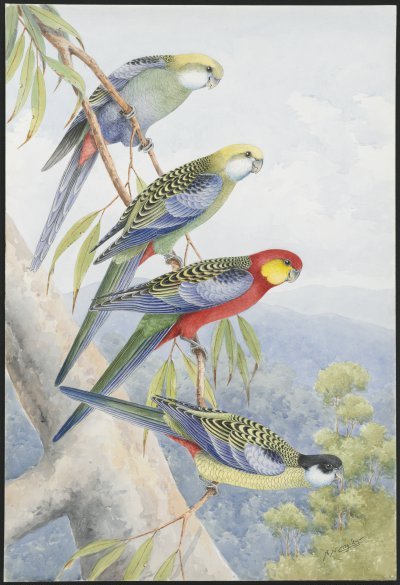 THE Crimson Rosella has a range extending from Cape York to Victoria, and occurs on Kangaroo, King, and Norfolk islands. The 'Lowry,' as it is frequently called, favours the more heavily timbered ranges, gullies, and scrubs to open country, and is very plentiful, even in localities quite close to the city. Itis well named 'elegans;' its crimson livery, strikingly marked with black on the back, with its dark blue tail, blue cheeks and shoulders, and graceful shape, affords a pleasing contrast to the green foliage of the trees. Although native fruits and seeds, especially the seeds of the different species of acacia, constitute its chief diet, unfortunately it has acquired a taste for certain fruits, being very troublesome to orchardists in some districts. Immature birds are dull olive-green in plumage; and it is usual for them to keep much to themselves; also they appear to be less wary when fully coloured adults. Like all the members of the genus, the Crimson resorts to a hollow limb or spout of a tree for the purposes of breeding, depositing five to eight white eggs on the decaying wood or dust found in these cavities.
THE Crimson Rosella has a range extending from Cape York to Victoria, and occurs on Kangaroo, King, and Norfolk islands. The 'Lowry,' as it is frequently called, favours the more heavily timbered ranges, gullies, and scrubs to open country, and is very plentiful, even in localities quite close to the city. Itis well named 'elegans;' its crimson livery, strikingly marked with black on the back, with its dark blue tail, blue cheeks and shoulders, and graceful shape, affords a pleasing contrast to the green foliage of the trees. Although native fruits and seeds, especially the seeds of the different species of acacia, constitute its chief diet, unfortunately it has acquired a taste for certain fruits, being very troublesome to orchardists in some districts. Immature birds are dull olive-green in plumage; and it is usual for them to keep much to themselves; also they appear to be less wary when fully coloured adults. Like all the members of the genus, the Crimson resorts to a hollow limb or spout of a tree for the purposes of breeding, depositing five to eight white eggs on the decaying wood or dust found in these cavities.
Right: Western rosella (Platycercus icterotis), Pale-headed rosella (Platycercus adscitus), Northern rosella (Platycercus venustus) [picture] [193-?] 1 watercolour ; 55 x 37.5 cm. by Neville William Cayley 1886-1950. Image no.: nla.pic-an6940217 courtesy National Library of Australia.
THE Yellow Rosella is an inhabitant of the inland portions of South Australia, Victoria, and New South Wales. It is rather a shy bird, and is mostly found in pairs or in small flocks, frequenting the tall gum-trees bordering river-banks or growing near swamps. In fact, it is seldom found far from where the eucalyptus flourishes, obtaining most of its food from the seeds and blossoms, and breeding in the hollow limbs. The birds vary considerably in plumage; the older they are the brighter the plumage. Some are particularly highly coloured, others quite pale in comparison. A fully-coloured adult is pale yellow, with black feathers margined with yellow on the back, forehead crimson, cheeks and upper wings blue, wing primaries brown, and the tail greenish, tipped light blue and white. Young birds are dull green.
THE Northern, or 'Smutty' Rosella, also commonly called 'Brown's Parrot'— so named after Dr. Robert Brown, the pioneer Australian botanist who accompanied Flinders in his exploration of the coast of Queensland — is an inhabitant of northern Australia. Very little has been written about the life history of this beautiful Parrot, although it appears to be fairly plentiful in some seasons of the year in the neighbourhood of Port Darwin. Recently a fine pair of these birds was added to the Taronga Park collection. In full livery an adult has the crown of the head and nape black, the cheeks white bordered with blue, the feathers of the hind-neck, back, and scapulars black margined with yellow, those of the rump and upper tail-coverts straw-yellow fringed with black; wings deep blue and black, the tail dark blue, tinged with green and tipped light blue and white; the feathers of the throat, chest, and abdomen straw-yellow fringed with black, and the under tail-coverts scarlet. Young birds are much duller in plumage.
THE Eastern, or Common, Rosella is plentifully distributed throughout the south-eastern portion of the Australian continent and most parts of Tasmania. It frequents alike scrub and open forest lands and mountain ranges, and passes much of its time on the ground in search of seeds of various grasses, which, with native fruits and berries, constitute its normal food. Unfortunately, like the Crimson Rosella, it is considered a pest, for it is very troublesome to orchardists and farmers, causing considerable damage to fruit and grain crops. Its scientific name, 'eximius,' is befitting a bird with such an excellent plumage; in fact, it is one of our most beautiful Parrots, and if it were not so common we would appreciate it at its true worth. They make interesting pets, easy to keep, and soon learn to imitate. The sexes are alike; a fully plumaged adult has the head, sides of neck, and upper breast scarlet, nape yellow; the feathers of the back and scapulars black, margined with yellowish -green ; rump and upper tail-coverts yellowish-green; shoulders of wing blue, with black patch on the inner side; greater coverts violet-blue; primaries dark blue; central tail-feathers, blue tinged with green, remainder blue at base tipped light blue and white; lower, breast yellow; abdomen yellowish-green, and under , tail-coverts scarlet.
Next Week: Red-Capped, Ring-Necked, and Port Lincoln Parrots. Feathered Beauties of the Australian Bush. (1926, March 17).Sydney Mail (NSW : 1912 - 1938), p. 13. Retrieved from http://nla.gov.au/nla.news-article160389906
Pictures by A J Guesdon.